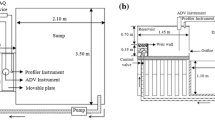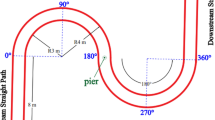Abstract
Scour at river bend is a complex process involving various parameters. Experiments were conducted in two laboratory flumes having 90° and 180° bends to study the influence of different parameters on scour at bends. Uniform non-cohesive sediments having median diameters varying from 0.28 to 1.18 mm were used as bed materials under different flow conditions. Three different cross-sectional shapes of the bed, namely flat, trapezoidal and parabolic, were used to study the effect of shape on scour. From the experiments, it is found that, at 90° bend, maximum scour and deposition occurred on concave and convex bank, respectively, between 50° and 60° azimuthal sections, whereas for 180° bend, the location was between 130° and 140° sections. Magnitude of scour was maximum for parabolic bed on the concave bank under flooded condition and deposition was maximum for flat bed on convex side. The deposition pattern on trapezoidal and parabolic bed was also different than that of flat bed. Again, for the same shear velocity ratio, the bigger size bed sediment produced larger scour depth but, for the same bed particle size, scour was more for greater approach shear velocity ratio. Further, measured three-dimensional time averaged velocity components before and after the scour on the 180° bend having initial parabolic bed shows the dominance of a spiral flow at the first half of the bend, and cross-flow from concave to convex at lower layer of the second half of the bend. The combined effect of vortex, cross-flow and accelerated flow is responsible for the erosion on the concave bank and deposition on the convex bank.






















Similar content being viewed by others
References
Barbhuiya AK, Dey S (2004) Local scour at abutments: a review. Sadhana. Indian Acad Sci 29(139):449–476
Barbhuiya AK, Talukdar S (2010) Scour and three dimensional turbulent flow fields measured by ADV at a 90° horizontal forced bend in a rectangular channel. Flow Meas Instrum 21(3):312–321
Blanckaert K, de Vriend HJ (2003) Nonlinear modeling of mean flow redistribution in curved open channels. Water Resour Res 39(12):1375–1381
Blanckaert K, de Vriend HJ (2004) Secondary flow in sharp open-channel bends. J Fluid Mech 498(1):353–380
Blanckaert K, Graf WH (2001) Mean flow and turbulence in open-channel bend. J Hydraul Eng 127(10):835–847
Blanckaert K, Graf WH (2004) Momentum transport in sharp open-channel bends. J Hydraul Eng 130(3):186–198
Chiew YM (1995) Mechanics of riprap failure at bridge piers. J Hydraul Eng 121(9):635–643
David SB, Charles ME, Chester CW (1997) The WES stream investigation and streambank stabilization handbook. U.S. Army Engineer waterways experiment station (WES).Vicksburg, Mississippi
Dey S, Barbhuiya AK (2004) Clear water scour at abutments. Water Manag J 157(2):77–98
Dietrich WE, Whiting PJ (1989) Boundary shear stress and sediment transport in river meanders of sand and gravel. In: Ikeda S, Parker G (eds) River Meandering, water resources monograph series, vol 12. American Geophysical Union, Washington DC, pp 1–50
Engelund F (1974) Flow and bed topography in channel bends. J Hydr Div 100(HY11):1631–1648
Garde RJ, Subramanya K, Nambudripad KD (1961) Study of scour around spur-dikes. J Hydraul Div Am Soc Civ Eng 87:23–37
Gill MA (1972) Erosion of sand beds around spur-dikes. J Hydraul Div Am Soc Civ Eng 98:1587–1602
Goring DG, Nikora VI (2002) Despiking acoustic Doppler velocimeter data. J Hydraul Eng 128(1):117–126
Ikeda S, Yamasaka M, Chiyoda M (1987) Bed topography and sorting in bends. J Hydraul Eng 113(2):190–206
Jamieson EC, Rennie CD, Townsend RD (2013) 3D flow and sediment dynamics in a laboratory channel bend with and without stream barbs. J Hydraul Eng 139(2):154–166
Johannesson H, Parker G (1989) Secondary flow in mildly sinuous channel. J Hydraul Eng 115(3):289–308
Kandasamy JK (1989) Abutment scour. Rep. No. 458, School of Engineering, University of Auckland, Auckland, New Zealand
Mockmore C (1943) Flow around bends in stable channels. Trans ASCE 3:334
Odgaard AJ (1982) Bed characteristics in alluvial channel bends. J Hydraul Div Am Soc Civ Eng 108(11):1268–1281
Roca M, Martin-Vide JP, Blanckaert K (2007) Reduction of bend scour by an outer bank footing: footing design and bedtopography. J Hydraul Eng 133(2):139–147
Rozovskii IL (1957) Flow and water in bends of open channels. Academy of Sciences of the Ukrainian SSr, The Israel Program for Scientific Translations, Jerusalem, Israel
Rozovskii IL (1961) Flow of water in bends of open channels. The Israel Program for Scientific Translations, Jerusalem, Israel
Ruther N, Olsen NR (2005) Three-dimensional modeling of sediment transport in a narrow 90° channel bend. J Hydraul Eng 131(10):917–920
Schlichting H (1979) Boundary layer theory. McGraw-Hill Book Co, New York
Shukhry A (1949) Flow around bends in an open flume. J Hydraul Div ASCE 75:713
Sontek Inc (2001) ADV operation manual, 1st edn. Sontek Inc., San Diego
Struiksma N, Olesen KW, Flokstra C, de Vriend HJ (1985) Bed deformation in curved alluvial channels. J Hydraul Res 23(1):57–79
Termini D (2009) Experimental observations of flow and bed processes in large-amplitude meandering flume. J Hydraul Eng 135(7):575–587
Thompson J (1876) On the origin and winding of rivers in alluvial plains, with remarks on flow around bends in pipes. Proc R Soc London 25:5
Wahl TL (2000) Analyzing ADV data using Win ADV. In: Proceedings, joint conference on water resources engineering and water resources planning & management, Minneapolis, pp 1–10
Whiting PJ, Dietrich WE (1993) Experimental studies of bed topography and flow patterns in large-amplitude meanders: 1. Observ Water Resour Res 29(11):3605–3614
Yalin MS, Ferreira da Silva AM (2001) Fluvial processes, IAHR Monograph. Balkema, Delft
Yen BC (1965) Characteristics of subcritical flow in a meandering channel. (Doctoral desertation). Retrieved from University of Iowa, Iowa City, Iowa
Acknowledgements
Funding provided by the Department of Science and Technology (DST), Govt. of India, vide DST No: SR/S3/MERC/095/2008 is appreciated. The experiments for this study were conducted at the NIT Silchar, Assam, India. The authors are grateful for the support provided by the staff.
Author information
Authors and Affiliations
Corresponding author
Rights and permissions
About this article
Cite this article
Biswas, P., Barbhuiya, A.K. Scour at River Bend: A Parametric Study. Iran J Sci Technol Trans Civ Eng 44, 1001–1021 (2020). https://doi.org/10.1007/s40996-020-00414-9
Received:
Accepted:
Published:
Issue Date:
DOI: https://doi.org/10.1007/s40996-020-00414-9




